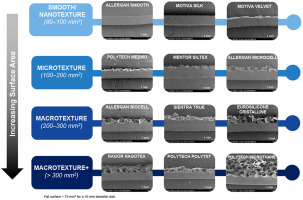Journal of the Mechanical Behavior of Biomedical Materials ( IF 3.9 ) Pub Date : 2018-08-28 , DOI: 10.1016/j.jmbbm.2018.08.035 Michael Atlan , Gina Nuti , Hongpeng Wang , Sherri Decker , TracyAnn Perry

|
Background
Surface texture of a breast implant influences tissue response and ultimately device performance. Characterizing differences among available surface textures is important for predicting and optimizing performance.
Methods
Scanning electron microscopy (SEM) and X-ray computed tomography (CT)-imaging were used to characterize the topography and surface area of 12 unique breast implant surface textures from seven different manufacturers. Samples of these surface textures were implanted in rats, and tissue response was analyzed histologically. In separate experiments, the force required to separate host tissue from the implant surface texture was used as a measure of tissue adherence.
Results
SEM imaging of the top and cross section of the implant shells showed that the textures differed qualitatively in evenness of the surface, presence of pores, size and openness of the pores, and the depth of texturing. X-ray CT imaging reflected these differences, with the texture surface area of the anterior of the shells ranging from 85 to 551 mm2, which was 8–602% greater than that of a flat surface. General similarities based on the physical structure of the surfaces were noted among groups of textures. In the rat models, with increasing surface texture complexity, there was increased capsule disorganization, tissue ingrowth, and tissue adherence.
Conclusions
Surface area and topography of breast implant textures are important factors contributing to tissue ingrowth and adherence. Based on surface area characteristics and measurements, it is possible to group the textures into four classifications: smooth/nanotexture (80–100 mm2), microtexture (100–200 mm2), macrotexture (200–300 mm2), and macrotexture-plus (> 300 mm2).
中文翻译:

乳房植入物的表面纹理影响宿主组织的反应
背景
乳房植入物的表面纹理会影响组织反应,并最终影响设备性能。表征可用表面纹理之间的差异对于预测和优化性能很重要。
方法
使用扫描电子显微镜(SEM)和X射线计算机断层摄影(CT)成像来表征来自七个不同制造商的12种独特的乳房植入物表面纹理的形貌和表面积。将这些表面纹理的样品植入大鼠中,并组织学分析组织反应。在单独的实验中,将宿主组织与植入物表面纹理分离所需的力用作组织附着力的量度。
结果
植入物外壳顶部和横截面的SEM图像显示,质地在表面均匀性,孔的存在,孔的大小和开放度以及纹理化深度上在质上有差异。X射线CT成像反映了这些差异,贝壳前部的纹理表面积为85至551 mm 2,比平坦表面的纹理表面积大8–602%。在纹理组之间注意到了基于表面物理结构的一般相似性。在大鼠模型中,随着表面纹理复杂性的增加,胶囊的组织紊乱,组织向内生长和组织粘附也增加。
结论
乳房植入物质地的表面积和形貌是导致组织向内生长和粘附的重要因素。根据表面积特征和测量,可以将纹理分为四个类别:光滑/纳米纹理(80–100 mm 2),微观纹理(100–200 mm 2),宏观纹理(200–300 mm 2)和宏观纹理加(> 300 mm 2)。



























 京公网安备 11010802027423号
京公网安备 11010802027423号